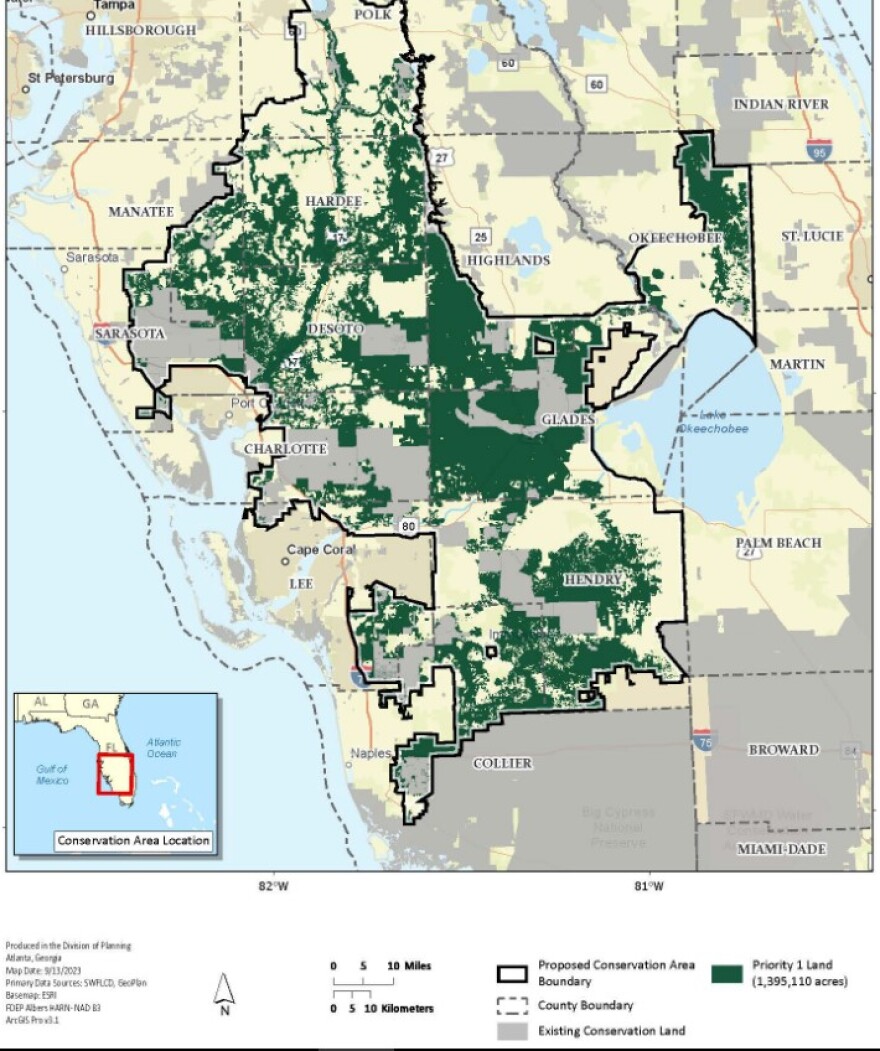The federal government is proposing a wildlife conservation area to include parts of twelve counties, ranging from Polk and Manatee south to Hendry and Collier. It includes the watersheds of the Peace River, Myakka River, Fisheating Creek and Caloosahatchee River.
It would use federal dollars to leverage existing projects, including a wildlife corridor that allows Florida panthers to migrate north from the Everglades.
This Everglades to Gulf Conservation Area would augment money from the state to preserve land.
Mallory Lykes Dimmitt is CEO of the Florida Wildlife Corridor Foundation. She says this could be another tool in the effort to create a wildlife corridor.
"It's a total opportunity for federal investment now to be able to be used in this protection boundary," she said. " It just gives more flexibility and another opportunity to say this is important. It ranks highly in the scores for programs that are out there."
Jason Lauritsen is Chief Conservation Officer of the Corridor Foundation.
"It's not the dollars that's going to make the difference. It's the fact that there's partnership," he said. "You can leverage those dollars for deals. You can have federal match in certain places. But it's also good when the private not-for-profits, the ranching community, the state and local governments and the federal government are all on the same page. It makes it easier to partner and sit down together."
The U.S. Fish and Wildlife Service is seeking comment from the public on the project through the end of October.
Please submit comments to: southeast_fws_planning@fws.gov or NWRS E2G CA, P.O. Box 700188, Wabasso, FL 32970.
Details, including information on public meetings, will be posted online at: https://www.fws.gov/project/everglade-to-gulf-conservation-area.

Here's a link to some frequently asked questions about the project.
Here's more information from the U.S. Fish and Wildlife Service:
The proposal is informed by extensive public engagement that included more than 30 informational discussions with representatives of over 70 local, State, Federal, Tribal, non-governmental agencies and private landowners; 7 public scoping meetings; a 35-day public scoping period; and the consideration of approximately 2,600 public comments, which were widely supportive. The resulting draft Land Protection Plan Environmental Assessment, and Conceptual Management Plan identify the vision, goals, objectives, acquisition boundary, and conceptual management for the proposed Everglades to Gulf Conservation Area. The Conservation Area, if approved, would weave together public and private land protection opportunities similar to the partnership approach implemented at the Everglades Headwaters National Wildlife Refuge and Conservation Area over a decade ago.
The proposal identifies a 4-million-acre Conservation Area in which the Service would pursue less-than-fee-title ( conservation easement ) or fee-title acquisitions from willing sellers only. Conservation easements would provide landowners the opportunity to maintain working lands in their current configuration with no further subdivision or development. The Service could acquire up to 10% of the Conservation Area, or 400,000 acres, in fee-title acquisitions where wildlife-dependent recreation opportunities such as hunting, fishing, wildlife observation, photography, environmental education and interpretation, and opportunities for cultural, traditional, and medicinal uses would be available.
The proposed Everglades to Gulf Conservation Area would protect species and improve their resiliency in the face of climate change and extreme development pressures. Protection and management actions would also support Florida’s family farms and ranches, improve water quality, quantity, and water storage within the Greater Everglades and watersheds entering Charlotte Harbor.
READ MORE: A 'pink wave' could spell good news for American Flamingo conservation in Florida
This area is home to many rare and endemic plants and animals, including over 70 federally or state-listed threatened and endangered species and iconic species like the Florida panther, Florida scrub jay, Audubon’s crested caracara, Everglade snail kite, and sand skink. The region is an ecologically diverse combination of wet prairie and freshwater marshes, forested wetlands, dry prairie and pine flatwoods, scrub/shrub, agricultural lands, and pastures. While some areas are conserved by state and national parks including wildlife management areas and Tribal lands, crucial wildlife corridors to connect these special places currently lack protection. A protected wildlife corridor from southwest Florida into the state’s northern stretches would allow Florida panthers and black bears, Everglade snail kites and other animals and plants to migrate away from increasingly impacted habitats.

Copyright 2023 WUSF 89.7. To see more, visit WUSF 89.7.






